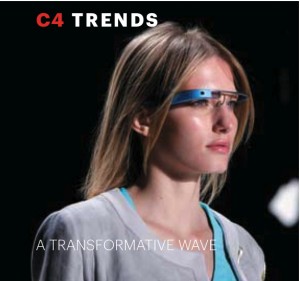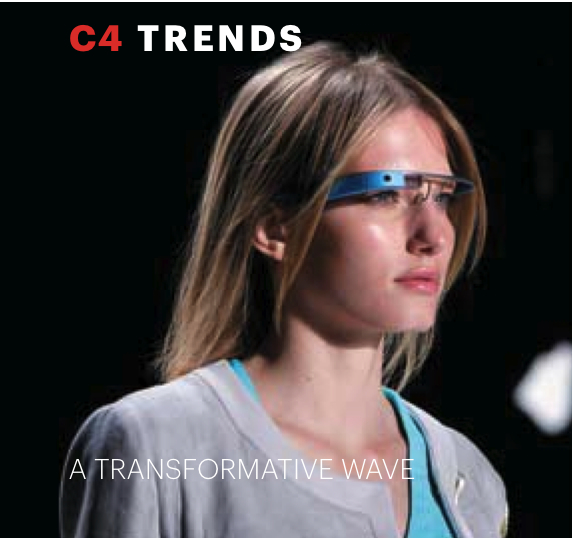 Wearable technologies are emerging from the lab onto the street, into the gym and onto the ski slopes. Today’s smartphones and tablets are like having a genie in a bottle. We pull from our pockets a mini, powerful computer and with a swipe or voice command get all of the information we need. We are at the beginning of this new form of “control and command.”
Wearable technologies are emerging from the lab onto the street, into the gym and onto the ski slopes. Today’s smartphones and tablets are like having a genie in a bottle. We pull from our pockets a mini, powerful computer and with a swipe or voice command get all of the information we need. We are at the beginning of this new form of “control and command.”
Google Glass is a new disruptive technology. These high tech glasses have the potential to take interaction to the next level by replacing swiping with voice commands, head gestures and simple tap controls to display and capture information, photos and videos in front of one of your eyes. This futuristic technology holds the promise of creating compelling user experiences that will fundamentally change how people communicate, socialize, entertain and collaborate using multimedia technologies to deliver intuitive, interactive and immersive audio and video experiences.
The first generation of Google Glass smart glasses with a readable overlay screen embedded in them was on parade at Diane von Furstenberg’s catwalk show. They are now testing these live on the street. A kind of “mediated” reality is seen as the future vision with information about shops, reminders of diary appointments, easy-to-use cameras and image sharing, and alternative routes all designed to make life easier.
Initially, geeks were thrilled by the promise of the eye-level connected screen and camera technology until it became threatening. Stop the Cyborgs, a London-based grassroots group, is lighting up the online universe with its campaign in response to the Google Glass project and other technology trends. The movement aims to stop an Orwellian future in which privacy is impossible and corporate control is complete. ‘Ban Google Glass’ signs are downloadable for free and they are looking to ignite the Twitterverse, declaring that anyone who would wear the devices is a “glasshole” or worse.
They fear that there is no way to know if you are being recorded and there also are issues with how this data collection will be used once it sits in the cloud.
The Tipping Point
Technology research companies predict that 2013 will mark the year wearable technology takes off. Google Glass is just one piece of a larger universe of wearable technologies. Juniper Research predicts that smart watches, wearable fitness devices and head-mounted displays will bring in $1.5 billion in revenue by 2014. And according to a report from IMS Research, wearable technology will represent a revenue opportunity of $6 billion by 2016.
Other major players such as Apple, Nike, Olympus and Sony are entering the field, in addition to less well-known companies like Pebble, mc10 and Recon Instruments. This surge is driven by miniaturization, new power sources and materials that are enabling the next-generation of sensors in head-up displays, wristbands, smart watches, smart glasses, jewelry, clothes and even contact lenses. Wearable technology will enable us to interact with our surroundings in new ways, be more informed of what is around us, and monitor and keep track of our lives.
Wearable technologies in health are expected to be a major IT market. While the current focus is on fitness, the emphasis on prevention from new healthcare laws in the U.S. will emerge as another major opportunity. The quantified self-monitoring movement is growing as it relates to adherence and behavior change. Wearable technologies may help aging seniors to live independently at home. These technologies also could provide tailored advice, reminders and information with feedback loops to family members or caretakers.
Nothing will drive the growth and applicability of technology more than the human interface. It’s up to designers and visionaries to develop ways in which Google Glass and other wearable IT technologies will change the interactions in our daily lives.
Reach Susan at: susan (at) c4trends – dot – com

